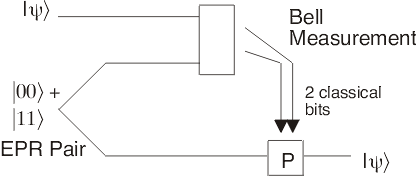
Quantum information has a number of uses, such as to create quantum computers or to perform quantum cryptographic protocols. One of the most basic tasks you can imagine performing for quantum information is moving it around. Of course, you could just encode the information in a single photon and send it through an optical fiber, but it might get lost along the way. This is a serious problem, since quantum information cannot be copied without losing its essential quantumness. One possible solution is to use a quantum error-correcting code to protect the qubits being sent. This will work, but is still technically quite difficult. A rather more straightforward way is to use a protocol known as quantum teleportation.
Quantum teleportation, in some sense, can be viewed as splitting up the "quantum" and "information" parts of quantum information. For Alice to teleport a quantum state to Bob, they must first share a particular type of entangled quantum state, an EPR pair. That is their "quantum" resource. Then to send her state to Bob, Alice first measures the state and her EPR pair, getting two classical bits. That gives her the "information" part, which she can then send to Bob. In the process, the original quantum state is destroyed, but Bob reconstructs it exactly. The quantum state has been "teleported" to Bob, even though only classical information passed to him from Alice.

In the above circuit, time moves from left to right. The top two lines represent qubits held by Alice, and the bottom line represents a qubit held by Bob. As you can see, Alice must make a particular type of measurement called a "Bell measurement" on her two qubits, and send to Bob the two classical bits that come out of it. Bob performs the operation P, which depends on the value of the two bits he receives from Alice.
Note that quantum teleportation has very little to do with moving about large objects: it is simply a way of substituting classical information for quantum information when we want to move the latter about. A large object like a chair needs an enormous amount of classical information to describe it completely, but the exact quantum state of a chair is unlikely to be of any interest. Therefore quantum teleportation is not going to be useful if you want to move a chair from Los Angeles to New York. On the other hand, if you want to move a single atom, then the quantum state might be crucial, and quantum teleportation can save you a good deal of trouble.
Another possible application of quantum teleportation is to help perform certain kinds of quantum gates.
Back to Daniel Gottesman's home page
Created October 19, 2001